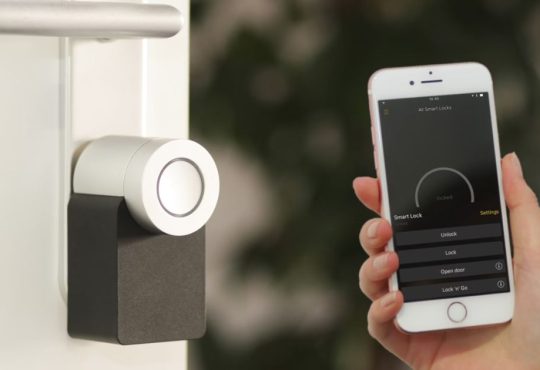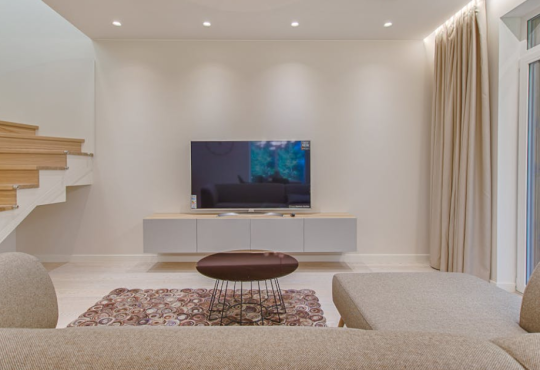Smart homes have revolutionized how we interact with our living spaces, offering convenience, efficiency, and enhanced security. From smart thermostats that optimize energy usage to voice-controlled lighting and AI-powered security systems, home automation has become more accessible than ever. However, despite the numerous benefits, there are also potential drawbacks that homeowners should consider before investing in smart technology. This article explores the pros and cons of building a smart home tech to help you determine if it’s the right choice for you.
Pros of Building a Smart Home
1. Convenience and Automation
One of a smart home’s biggest advantages is its convenience. Smart devices allow homeowners to remotely control lighting, climate, appliances, and security systems via smartphone apps or voice assistants like Amazon Alexa and Google Assistant. Automation enables users to set schedules for devices, such as having lights turn on when entering a room or the coffee maker start brewing before waking up.
2. Energy Efficiency and Cost Savings
Smart home devices can significantly reduce energy consumption, lowering utility bills. Smart thermostats, such as the Nest Learning Thermostat or Ecobee, adjust temperatures based on occupancy and weather conditions, optimizing energy usage. Smart lighting systems automatically turn off lights in unoccupied rooms, while smart plugs help manage energy consumption by cutting power to unused appliances.
3. Enhanced Security
A smart home can improve security through connected devices like smart locks, security cameras, motion detectors, and video doorbells. Homeowners can monitor their property in real-time through mobile apps and receive alerts for unusual activity. Features like facial recognition, remote locking/unlocking, and integration with law enforcement services enhance home safety.
4. Remote Access and Monitoring
With smart home technology, homeowners can control and monitor their homes from anywhere. Whether adjusting the thermostat, checking security camera footage, or unlocking the door for a delivery person, remote access provides peace of mind, especially for frequent travelers or those with second homes.
5. Increased Home Value
A well-integrated smart home system can increase property value and make a home more attractive to buyers. Many real estate experts highlight that buyers are willing to pay a premium for smart home features such as automated lighting, advanced security, and smart climate control.
6. Integration with Smart Assistants
Smart homes can be seamlessly integrated with voice assistants like Amazon Alexa, Google Assistant, and Apple’s Siri, making it easier to control multiple devices through a single command. This level of integration enhances user experience by allowing hands-free operation and customized automation routines.
7. Improved Accessibility for Elderly and Disabled Individuals
Smart home technology can greatly benefit individuals with mobility challenges, disabilities, or aging-related limitations. Features like voice-activated controls, automated lighting, and smart door locks enable greater independence. Smart home assistants can remind users to take medications, call emergency services, or even control appliances without physical effort.
8. Customization and Personalization
Smart homes offer extensive customization options, allowing homeowners to tailor their living environment to suit their preferences. From setting mood lighting for different activities to adjusting climate settings based on personal comfort levels, smart systems can learn user behaviors and create personalized experiences. Some advanced setups even allow multiple user profiles to accommodate different family members’ preferences.
9. Better Water and Utility Management
Beyond energy efficiency, smart homes can help manage water consumption and prevent costly damage. Smart irrigation systems optimize watering schedules based on weather conditions, reducing waste. Leak detection sensors alert homeowners to potential plumbing issues before they escalate, preventing water damage and excessive bills.
10. Enhanced Entertainment Experience
A smart home can create a fully immersive entertainment experience. Homeowners can sync smart speakers, smart TVs, and home theater systems for seamless audio-visual control. With automation, users can set up “movie night” modes, where lights dim, blinds close, and the TV turns on with a single command, enhancing convenience and ambiance.
11. Health and Wellness Monitoring
Smart home technology is expanding into health and wellness, providing features such as smart air purifiers, sleep trackers, and smart beds that adjust firmness based on sleep patterns. Some systems can also integrate with fitness trackers and smart kitchen appliances, helping users maintain healthier lifestyles by tracking activity, meal planning, and even monitoring air quality.
12. Reduced Insurance Costs
Some insurance providers offer discounts for homes with smart security systems, leak detectors, and fire prevention devices. Smart home features can lower premiums and long-term savings by reducing the risk of burglary, fire, or water damage.
Cons of Building a Smart Home
1. High Initial Costs
One of the main drawbacks of building a smart home is the initial investment. Purchasing smart devices, setting up a central hub, and integrating multiple systems can be expensive. High-end smart home setups with advanced automation can cost thousands of dollars, making them less accessible for some homeowners.
2. Privacy and Security Risks
While smart homes offer security enhancements, they also introduce privacy concerns. Smart devices collect and store data about user habits, raising concerns about potential data breaches and hacking attempts. If not properly secured, smart home devices can become entry points for cybercriminals who could access personal information or even control home systems remotely.
3. Complex Setup and Compatibility Issues
Integrating devices from different manufacturers complicates smart home setup. Not all smart devices are compatible with each other, and some require additional hubs or software for seamless operation. Homeowners may need technical expertise or professional installation to ensure everything works smoothly.
4. Dependence on Internet Connectivity
A major limitation of smart home technology is its reliance on an internet connection. Many smart devices require constant internet access to function correctly. If the network goes down, homeowners may lose control over essential devices, such as security cameras, smart locks, and climate control systems.
5. Frequent Updates and Potential Obsolescence
Technology evolves rapidly; smart home devices often require regular firmware updates to maintain security and functionality. Some manufacturers discontinue support for older models, making them obsolete over time. Homeowners may need to replace outdated devices or invest in newer technology to keep their systems running smoothly.
6. Learning Curve and User Adaptability
Learning how to use smart home technology can be challenging for nontech-savvy individuals. Navigating apps, setting up automation rules, and troubleshooting connectivity issues may require time and effort. Elderly users or those unfamiliar with digital interfaces may find adapting to a fully automated home difficult.
7. Increased Energy Consumption
While smart homes can improve energy efficiency, they can also contribute to higher energy usage. Some smart devices, such as always-on voice assistants, smart hubs, and Wi-Fi-connected security cameras, continuously consume power even when not in active use. This “phantom load” can increase electricity bills, offsetting potential energy savings.
8. Limited Interoperability Across Brands
Although smart home technology is improving, many devices operate within closed ecosystems. A smart thermostat from one brand may not work seamlessly with a smart lock or lighting system from another. This lack of standardization can frustrate homeowners in creating a unified smart home experience, often forcing them to commit to a single brand or platform.
9. Risk of System Malfunctions
Smart home systems rely on software and connectivity, making them susceptible to glitches, bugs, and malfunctions. A firmware update gone wrong, a server outage from the manufacturer, or even a simple app crash can render devices unusable. These failures can pose significant risks in critical situations, such as smart locks failing to respond or security cameras going offline.
10. Potential Privacy Invasion by Manufacturers
Beyond security risks from hackers, there’s also the issue of data collection by device manufacturers. Many smart home companies collect user data to improve their products or sell insights to third parties. This raises concerns about constant surveillance and how much personal information homeowners unwittingly share with corporations.
11. Difficulty in Repairs and Troubleshooting
Unlike traditional home appliances, smart home devices often require specialized repair knowledge. When a smart light switch or thermostat malfunctions, homeowners may be unable to fix it themselves. Unlike non-smart appliances with simpler mechanical components, smart devices often require manufacturer support or even complete replacement, adding to long-term costs.
12. Security Risks with Voice-Controlled Devices
Voice assistants like Amazon Alexa, Google Assistant, and Apple Siri provide convenience but also introduce security vulnerabilities. They can be triggered by unintended voices, including those from TV commercials or passersby outside an open window. In some cases, they may misinterpret commands or be exploited by malicious actors to gain access to sensitive data or control smart home devices.
Smart Home Devices: Enhancing Convenience, Efficiency, and Security
Smart home devices are internet-connected gadgets that enable homeowners to automate and remotely control various aspects of their homes. These devices enhance convenience, efficiency, and security, often functioning as part of a larger ecosystem that communicates through Wi-Fi, Zigbee, Z-Wave, or Bluetooth protocols.
Examples include:
- Smart Speakers: Voice-controlled assistants like Amazon Echo or Google Nest for tasks like playing music, managing schedules, or controlling other devices.
- Smart Lights: Bulbs that allow customizable brightness, colors, and scheduling, often controllable via apps or voice commands.
- Smart Thermostats: Devices that optimize heating and cooling based on user preferences and schedules.
- Smart Security Systems: Cameras, doorbells, or locks that allow monitoring and access control from anywhere.
- Smart Appliances: Refrigerators, washing machines, or vacuums with smart features for added functionality.
Weighing the Benefits and Risks for a Smarter Choice
Building a smart home offers numerous advantages, including convenience, energy efficiency, enhanced security, and increased property value. However, it also comes with high costs, privacy risks, compatibility issues, and reliance on internet connectivity. Before investing in smart home technology, homeowners should carefully weigh the pros and cons to determine if automation aligns with their lifestyle, budget, and security preferences.
A well-planned smart home setup can improve daily life, providing comfort and efficiency. However, it’s essential to stay informed about potential risks and invest in secure, compatible devices to ensure a seamless and safe smart home experience.





